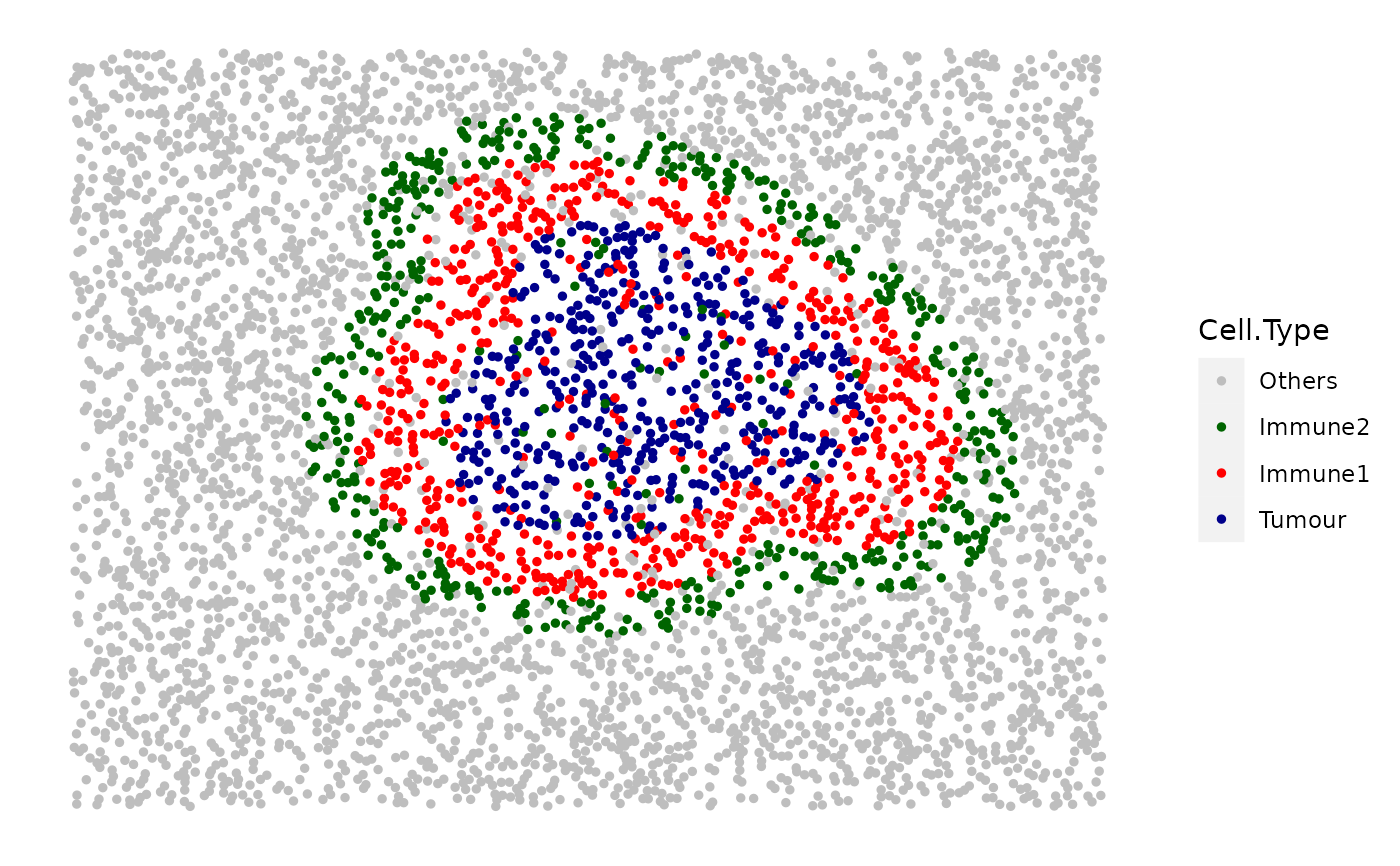Simulate double immune rings
simulate_double_rings.RdBased on an existing background image, simulate double rings of immune cells that surround tumour clusters. The inner ring is the internal margin of a tumour cluster. The outer ring is the external tumour margin. The tumour clusters and the double immune rings are simulated at the same time. The default values for the arguments give an example of double ring simulation which enable an automatic simulation of double rings without the specification of any argument.
simulate_double_rings(
bg_sample = bg1,
bg_type = "Others",
n_dr = 2,
dr_properties = list(D1 = list(name_of_cluster_cell = "Tumour", size = 300, shape =
"Circle", centre_loc = data.frame(x = 1000, y = 1000), infiltration_types =
c("Immune1", "Immune2", "Others"), infiltration_proportions = c(0.15, 0.05, 0.05),
name_of_ring_cell = "Immune1", immune_ring_width = 150,
immune_ring_infiltration_types = c("Others"), immune_ring_infiltration_proportions =
c(0.15), name_of_double_ring_cell = "Immune2", double_ring_width = 100,
double_ring_infiltration_types = c("Others"), double_ring_infiltration_proportions =
c(0.15)),
D2 = list(name_of_cluster_cell = "Tumour", size = 300, shape =
"Oval", centre_loc = data.frame(x = 1200, y = 1200), infiltration_types =
c("Immune1", "Immune2", "Others"), infiltration_proportions = c(0.15, 0.05, 0.05),
name_of_ring_cell = "Immune1", immune_ring_width = 150,
immune_ring_infiltration_types = c("Others"), immune_ring_infiltration_proportions =
c(0.15), name_of_double_ring_cell = "Immune2", double_ring_width = 100,
double_ring_infiltration_types = c("Others"), double_ring_infiltration_proportions =
c(0.15))),
plot_image = TRUE,
plot_categories = NULL,
plot_colours = NULL
)Arguments
- bg_sample
(OPTIONAL) A data frame or
SpatialExperimentclass object with locations of points representing background cells. Further cell types will be simulated based on this background sample. The data.frame or thespatialCoords()of the SPE object should have colnames including "Cell.X.Positions" and "Cell.Y.Positions". By default use the internalbg1background image.- bg_type
(OPTIONAL) String The name of the background cell type. By default is "Others".
- n_dr
Number of double immune rings. This must match the
length(dr_properties).- dr_properties
List of properties of the double immune rings. Please refer to the examples for the structure of
dr_properties.- plot_image
Boolean. Whether the simulated image is plotted.
- plot_categories
String Vector specifying the order of the cell categories to be plotted. Default is NULL - the cell categories under the "Cell.Type" column would be used for plotting.
- plot_colours
String Vector specifying the order of the colours that correspond to the
plot_categoriesarg. Default is NULL - the predefined colour vector would be used for plotting.
Value
A data.frame of the simulated image
See also
simulate_background_cells for all cell simulation,
simulate_mixing for mixed background simulation,
simulate_clusters for cluster simulation,
simulate_immune_rings for single immune ring simulation, and
simulate_stripes for vessel simulation.
Other simulate pattern functions:
simulate_background_cells(),
simulate_clusters(),
simulate_immune_rings(),
simulate_mixing(),
simulate_stripes()
Examples
set.seed(610)
# manually define the properties of the immune ring
dr_properties <- list(D1 = list(name_of_cluster_cell = "Tumour",size = 300,
shape = "Circle",centre_loc = data.frame("x" = 1000, "y" = 1000),infiltration_types
= c("Immune1", "Immune2", "Others"),infiltration_proportions = c(0.15, 0.05, 0.05),
name_of_ring_cell = "Immune1",immune_ring_width = 150,immune_ring_infiltration_types
= c("Others"),immune_ring_infiltration_proportions = c(0.15),name_of_double_ring_cell
= "Immune2",double_ring_width = 100,double_ring_infiltration_types = c("Others"),
double_ring_infiltration_proportions = c(0.15)),
D2 = list(name_of_cluster_cell = "Tumour",size = 300,shape = "Oval",centre_loc
= data.frame("x" = 1200, "y" = 1200),infiltration_types = c("Immune1", "Immune2", "Others"),
infiltration_proportions = c(0.15, 0.05, 0.05),name_of_ring_cell = "Immune1",
immune_ring_width = 150,immune_ring_infiltration_types = c("Others"),
immune_ring_infiltration_proportions = c(0.15),name_of_double_ring_cell = "Immune2",
double_ring_width = 100,double_ring_infiltration_types = c("Others"),
double_ring_infiltration_proportions = c(0.15)))
double_ring_image <- simulate_double_rings(bg_sample = bg1,
n_dr = 2, dr_properties = dr_properties)
